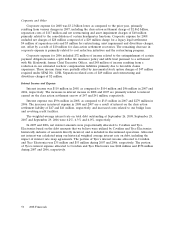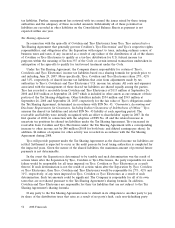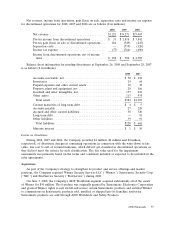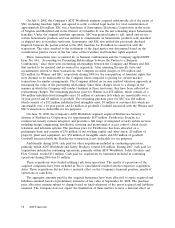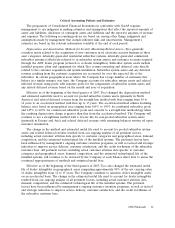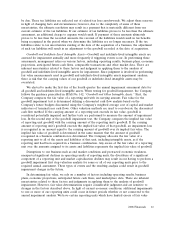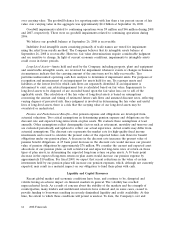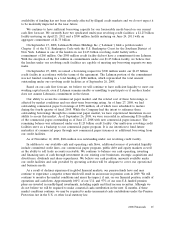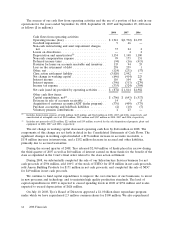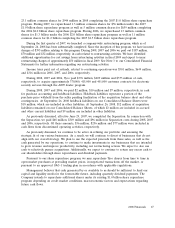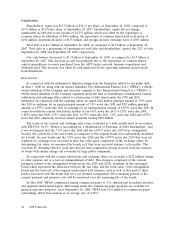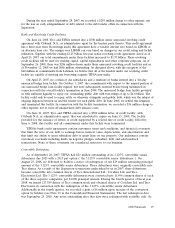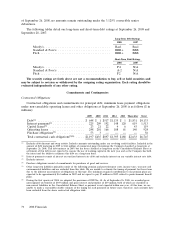ADT 2008 Annual Report Download - page 163
Download and view the complete annual report
Please find page 163 of the 2008 ADT annual report below. You can navigate through the pages in the report by either clicking on the pages listed below, or by using the keyword search tool below to find specific information within the annual report.cash flow method. If the carrying amount of a reporting unit exceeds its fair value, goodwill is
considered potentially impaired. During the annual goodwill impairment testing for the fiscal year
ended September 26, 2008, the carrying amount of goodwill in the Latin America Fire Protection
business, part of the Fire Protection Services segment, exceeded the implied fair value of goodwill. As a
result, the Company recognized a goodwill impairment of $9 million in the fourth quarter of 2008.
Furthermore, the Company believes its goodwill balance at September 26, 2008 is recoverable.
In connection with the Separation, during the third quarter of 2007 Tyco reorganized into a new
management and segment reporting structure. As part of these organizational changes, the Company
assessed new reporting units and conducted valuations to determine the assignment of goodwill to the
new reporting units based on their estimated relative fair values. Following the relative fair value
goodwill allocation, the Company then tested goodwill for impairment by comparing the fair value of
each reporting unit with its carrying value amount. If the carrying amount of a reporting unit exceeded
its fair value, goodwill was considered potentially impaired. Where goodwill was potentially impaired,
we compared the implied fair value of the reporting unit goodwill to the carrying amount of that
goodwill. The carrying amount of goodwill exceeded the implied fair value of goodwill in the Australia
and New Zealand Security Services business, part of the ADT Worldwide segment. As a result, the
Company recognized a goodwill impairment of $46 million in the third quarter of 2007.
In determining fair value, management relies on a number of factors including operating results,
business plans, economic projections, anticipated future cash flows and marketplace data. There are
inherent uncertainties related to these factors and judgments in applying them to the analysis of
goodwill impairment. However, fair value determinations require considerable judgment and are
sensitive to changes in the factors described above. In light of current economic conditions, additional
impairments to one or more of our reporting units could occur in future periods whether or not
connected to the annual impairment analysis. The Company has certain reporting units which have
limited excess of fair value over carrying value. The goodwill balance for reporting units with less than
a ten percent excess of fair value over carrying value in the aggregate was approximately $2.4 billion at
September 26, 2008.
Cumulative Effect of Accounting Change
During 2006, the Company adopted Financial Accounting Standards Board Interpretation (‘‘FIN’’)
No. 47, ‘‘Accounting for Conditional Asset Retirement Obligations—an Interpretation of FASB Statement
No. 143.’’ FIN No. 47 clarifies the timing of liability recognition for legal obligations associated with an
asset retirement when the timing and (or) method of settling the obligation are conditional on a future
event that may or may not be within the control of the entity and clarifies when an entity would have
sufficient information to reasonably estimate the fair value of an asset retirement obligation. FIN
No. 47 requires that conditional asset retirement obligations, along with the associated capitalized asset
retirement costs, be initially reported at their fair values. Upon adoption, the Company recognized a
liability of $32 million for asset retirement obligations and an increase of $10 million in the carrying
amount of the related assets, of which $19 million and $5 million are reflected in liabilities and assets
of discontinued operations, respectively. The initial recognition resulted in a cumulative effect of
accounting change of $14 million after-tax loss ($22 million pre-tax), reflecting the accumulated
depreciation and accretion that would have been recognized in prior periods had the provisions of FIN
No. 47 been in effect at the time.
60 2008 Financials


